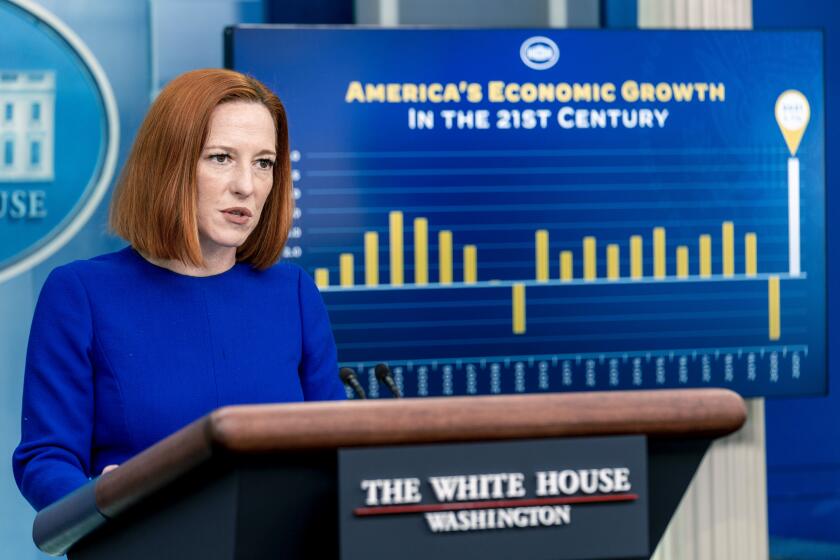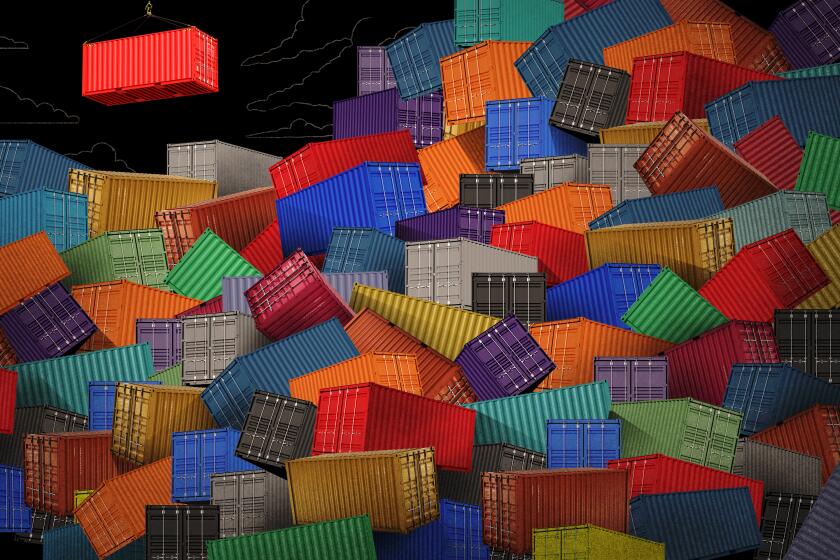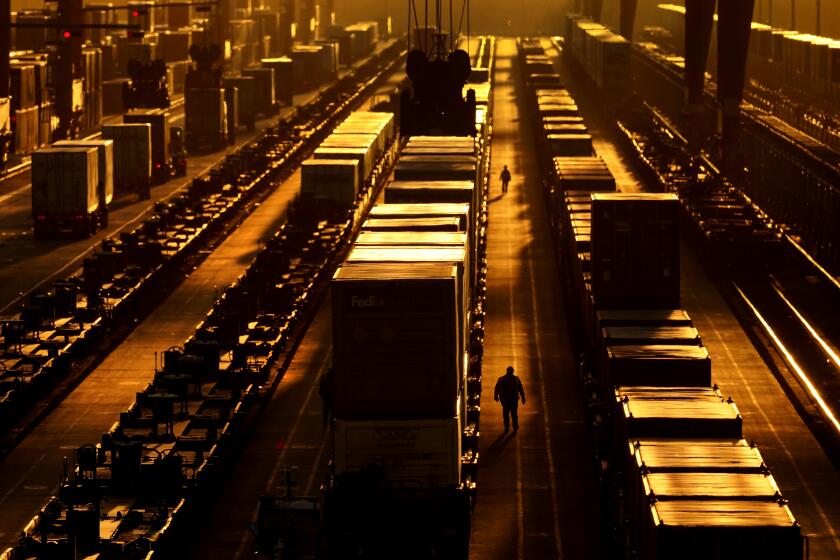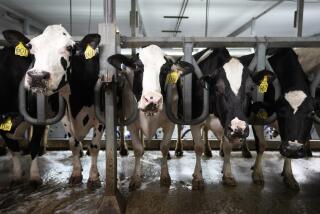Your package was delivered on time? You’ve got this supply chain workaround to thank
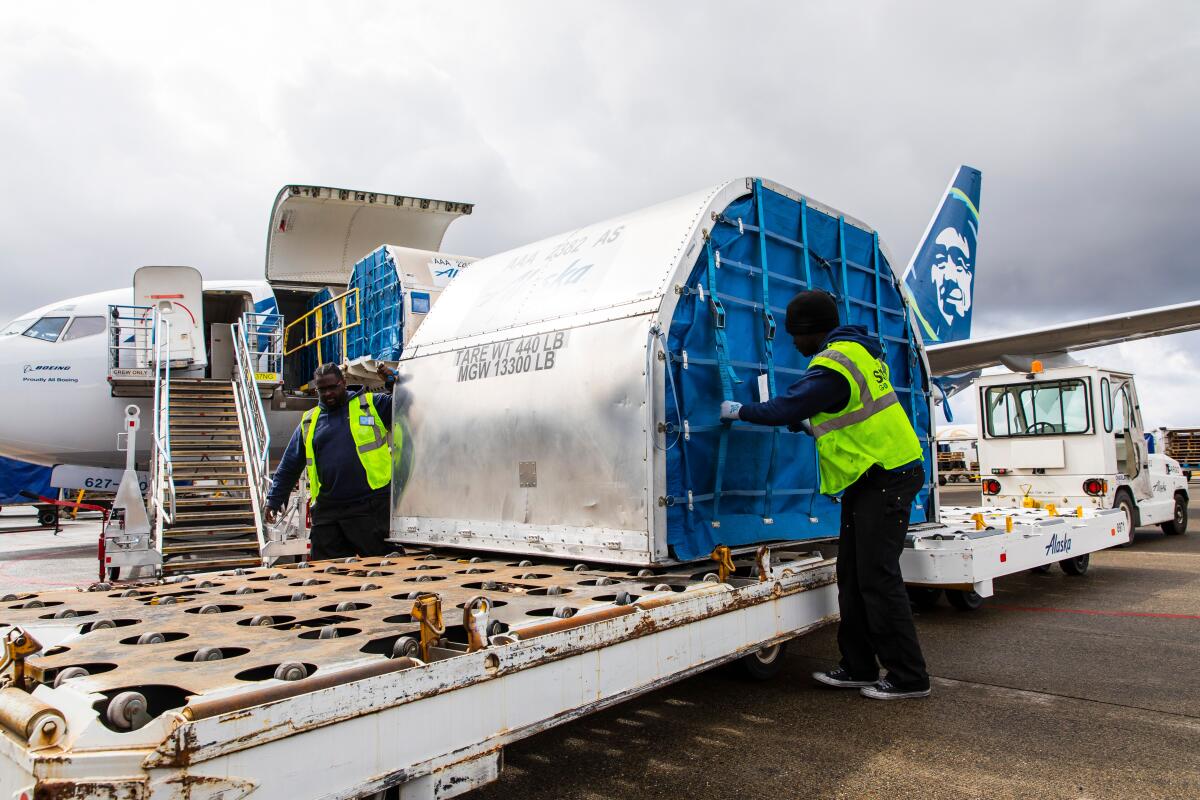
- Share via
If your seafood is fresher and your online order arrives on time, thank the pandemic: Supply-chain disruptions are actually getting some things delivered faster.
Manufacturers, retailers and seafood distributors have increasingly turned to air cargo planes to transport products — a more expensive, but faster and more reliable, alternative to long-haul trucks, trains and ocean vessels bogged down by pandemic-related problems.
“When the going gets tough, the supply chains turn to air cargo,” said Michael Zimmerman, a supply-chain expert and partner at the management consulting firm Kearney.
The pivot came in response to a surge in online orders from Americans confined at home due to COVID-19, as well as the turmoil in the traditional supply chain, spurred by factory shutdowns in the early months of the pandemic and worker shortages, among other issues. The supply-chain problems are one reason prices for many goods have exploded, with inflation hitting a new 40-year high Tuesday.
Inflation hit a 40-year high Tuesday, as the rising cost of goods continues to sour Americans’ feelings about an otherwise robust economy.
The volume of goods shipped by air in 2021 rose by nearly 19% compared with the previous year, according to the International Air Transport Assn., a trade group for the world’s airlines. That year, 2021, saw the highest volume of air cargo since 2010, the group said.
Demand has grown so fast that airlines, ocean shipping companies and aircraft manufacturers have begun to invest heavily in new air cargo planes or in converting existing passenger planes to carry only cargo.
Facilities where passenger planes are transformed into cargo planes — by pulling out passenger seats, reinforcing the floor and adding bigger doors — are expanding in China, Canada, Costa Rica and England.
Airbus, the European aircraft manufacturer, estimates that the world will need about 2,440 additional cargo planes, of which 880 would be newly built and 1,560 would be conversions, over the next 20 years.
Air cargo planes have limitations. Air freighters cannot transport flammable goods, and because shipping by air is costly — up to 20 times more expensive — manufacturers and retailers try to limit air freight to high-value, low-weight items such as microprocessors for cellphones, pharmaceuticals, cut flowers, jewelry, live animals and pricey clothing.
One of the biggest reasons for the increased demand in air cargo was the surge in online shopping brought on by the pandemic. Target reported a 12.7% growth in sales to $106 billion in the 2021 fiscal year from $94 billion in 2020. The retail giant attributed about half of its growth to online sales. In 2021, net sales at Amazon increased by 22% to $469.8 billion, compared with $386.1 billion in 2020.
To meet the higher demand, Amazon bought four planes last year from the Canadian airline WestJet and seven aircraft from Delta Air Lines to grow its air fleet to more than 80 planes, according to Amazon.
“Our goal is to continue delivering customers across the U.S. in the way that they expect from Amazon,” Sara Rhoads, vice president of Amazon Global Air, said in a statement. The retail giant declined to comment further on the subject.
A global supply chain breakdown has resulted in gridlock at the ports of Los Angeles and Long Beach and beyond.
When most air travelers stopped flying at the start of the pandemic, airlines eliminated dozens of passenger flights, which meant those planes could no longer carry cargo in the belly of the planes. A few airlines packed empty passenger planes with cargo in the cabin but others, like Alaska Airlines, began to invest in cargo planes.
Air cargo also grew in response to the logjams among logistic companies, such as long-haul shippers that had to deal with COVID-19 outbreaks among workers. The disruptions made traditional logistics less reliable and more expensive, which made the cost of transporting by air more competitive — in relative terms, according to the International Air Transport Assn. Instead of being 10 to 20 times more expensive, shipping by air is now about six times more expensive than the traditional alternatives, the trade group reported.
“The demand for air cargo capacity is high, and it’s going to stay high,” Zimmerman said.
Alaska Airlines, which has three planes dedicated to air freight, announced plans last month to convert two of its Boeing 737-800 passenger aircraft to cargo planes. The additional planes will help transport fresh produce, medical supplies, building materials, machine parts, appliances, furniture, e-commerce deliveries, mail and fresh seafood from Alaska fisheries, according to the airline.
“Fresh seafood commands a premium price for processors over frozen product, so as we bring more freighters to the market, we’ll have more capacity to transport fresh seafood out of Alaska than we can today,” Alaska spokesperson Maria Cid said.
COVID-19 led to logjams at ports and borders that continue to ripple through many parts of our economy and everyday life. When will it get better?
Danish logistics giant A.P. Moller-Maersk bought an air freight company last year to add to its fleet of ships, trains and trucks, and France’s CMA CGM created a new air freight division.
Boeing announced it had a record 84 orders for cargo planes in 2021, surpassing its previous record of 83 in 2019. That’s in addition to more than 100 orders and commitments made last year to convert passenger planes into cargo aircraft.
So far this year, Boeing has announced orders from Qatar Airways for 34 new 777X freighters with an option for 16 more and an order for four 777s from China Airlines. Dublin-based ASL Aviation Holdings ordered up to 20 converted freighters.
“Cargo used to be an afterthought,” said Brian Hermesmeyer, a spokesperson for Boeing. “They are thinking about cargo now. It’s getting a seat at the table.”
California’s small businesses waded through COVID to a rebound in consumer spending, only to face rising costs for supplies and wages.
Boeing operates 11 facilities to convert passenger jets into cargo planes and has announced plans to add nine new conversion lines.
The process of converting a passenger plane into a cargo aircraft can take several months, depending on the plane and the demand at the conversion facilities.
The conversions typically involve older passenger planes that would otherwise be parked in a remote airport and picked apart for parts or sold to a foreign airline.
“When we have planes at that point in life, they go either into the desert, another airline or become freighters,” Hermesmeyer said. “This way we get 10 to 15 more years out of them.”
More to Read
Inside the business of entertainment
The Wide Shot brings you news, analysis and insights on everything from streaming wars to production — and what it all means for the future.
You may occasionally receive promotional content from the Los Angeles Times.
